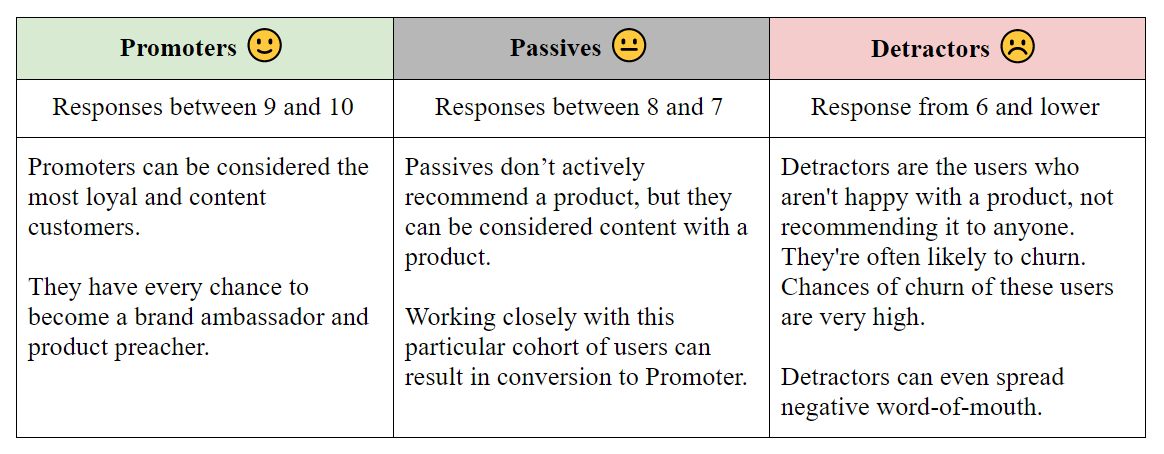In the SaaS sphere, it is widely agreed that NPS should be a key performance indicator of any Customer Success Team. As an agreer myself, I believe we should take this idea even further. I believe that all departments should track this metric because each is trying to develop a customer's loyalty.
In this article, we’ll share a ready-made action plan to increase your NPS score; an indicator that your customers are happy. The strategies discussed in this plan have been tried and tested by the teams at NetHunt, and we’re proud to share our results.
Let's dig in with the basics. I want to dive deeper into the strategies marketing, sales, and product teams use to develop company growth whilst increasing our NPS score.
What is NPS, and why is it important?
Net Promoter Score (NPS) is a metric that tracks how a company's product or service is being perceived by their customers. As a direct indicator of growth and customer satisfaction, it's already regarded as a primary KPI for customer success teams to monitor. But at NetHunt, we believe this particular metric can be more widely used.
A top NPS score results from an aligned effort of the development, marketing, sales, and customer service departments. Only their combined knowledge of feature development, audience, correct messaging, lead nurturing, and timely customer service, used together, can result in a high NPS score for a business.
How to calculate NPS score?
It’s a good question, but not as good as the question we need to ask our users to figure out our NPS score. Yep, all we need to do is ask our users one, simple question.
How likely is it that you would recommend [Organization/Product/Service] to a friend or colleague?
Answers should be given rated on a linear scale from one; not likely, to 10; definitely. It looks a little something like this.

Based on these answers, customers fall between three different categories, laid out below.

After running the survey, waiting, and receiving all the answers, it’s finally time to calculate your NPS score. It’s a big moment if you’re doing it for the first time. Is it high enough? Should I be nervous about the health of my business? Luckily, the maths is simple enough. All we need to do is subtract the percentage of Detractors away from the percentage of Promoters.
NPS=% Promoters - % Detractors
Alternatively, you can always use a dedicated software which runs NPS score surveys for you. Obviously, they do all the heavy lifting in return for a small sum. They will calculate your final score.
If you want to calculate NPS score by yourself, we've prepared a template in Google Sheets to take all the work off your shoulders!

Try this simple NPS Calculator
What is a good NPS score?
There are no set-in-stone rules for NPS scores, but you can generally consider anything above 30 to be okay. It's all relative, and the best gauge you can get on a current NPS score is by comparing it with one from a previous time-frame. Similarly, you can try to find an industry-standard NPS score as a benchmark for your score. Finding out you're outperforming competitors is always a pleasant surprise.
Some thinkers believe that any NPS score higher than 0 is good since an NPS score can be in the negatives. Whilst it's always good to stay in the positives, I'd recommend not setting your bar this low. The higher your NPS score, the better.
The road to an entirely satisfactory NPS score is long and winding; many people say it is infinite. Industries constantly evolve, user needs and expectations are always increasing. However, this isn't the downside for NPS score collection; it's just part of the journey. The downside of NPS scoring is that it often brings many false-positive results, so you should take it with a pinch of salt.
How often should an NPS score be calculated?
Again, there are no rules. NPS score frequency changes based on variables such as differences between transactional and relationship-driven business models, user lifecycle, and product update frequency. Many companies choose to run their NPS surveys every six months, but it's up to you.
Here is our recommended NPS survey interval pattern👇
- An initial survey should be carried out between 7 - 14 days after user registration.
- A moment-of-truth survey should be carried out between 30 - 90 days after the initial survey.
- A third survey should be carried out 90 days after the second survey.
- A recurring survey should run quarterly after initial surveys have been completed.
In fact, here are a whole bunch of actionable NetHunt tips for NPS scoring .
🔥 NetHunt tips for measuring NPS scores 🔥
- Don’t limit your NPS surveys to just first-time buyers.
Ask regular clients as well, because their brand perception is free to change over time. - Don’t survey customers immediately after a major product update.
They might not be used to new features or UI; they might even be angry. This is likely to change. - Don't overdo NPS surveying.
Whilst it's an excellent way to gauge customer behaviour, it's best not to include an NPS survey at every touchpoint. - Don’t send an NPS survey to your whole customer base at the same time.
Your product isn’t the same fit for every customer segment. It’s best to make NPS scores more actionable by attributing different scores to specific cohorts. Over time, you’ll be able to track how each product change has affected each cohort individually.
How can an NPS score affect customer loyalty?
As customers ourselves, we don't formulate our opinions based on a product alone. It's all parts of equal branding, customer service, and value delivery that have the desired influence on customers; customer centricity should be the foundation of every department's customer-facing activities. The marketing and design teams, to sales and customer service employees, and of course, the developers should all be working towards the same, collective NPS-driven goal.
The Marketing Team
The most significant impact the marketing team can have on an NPS score is by ensuring the perception of product value for a client is the correct one.
The marketing team should create open lines of communication and messaging that resonates with a business's ideal customer profile (ICP). They need to make sure that this messaging addresses relevant pain points and they should guarantee that a user's post-registration experience is as they would expect it to be.
Example 👉 Imagine the marketing team made a point of a client being at the centre of everything we do. Then, a customer has a problem with their purchase, and for whatever reason, it takes a week to get it fixed. Similarly, if you shout about a product's functionality whose release date isn't due for another year… to acquire more, slightly disappointed, leads. Both scenarios affect your NPS score, and worse, your brand-consumer trust.
We need to make sure marketing output is transparent and pays attention to our clients' emotional needs. Use accurate wording to ensure that any user or potential user feels safe, valued, and understands the value the product is giving them.
- The marketing team maintains an extensive product knowledge-base.
At NetHunt, each marketing team member passes a training programme once they have joined our company. Going further, they spend some time with the Customer Success Department, listening to demo calls and internal discussions to understand the product further. After the World went remote in 2020, the marketing team joined demo calls online to understand customer questions and to learn how to speak a customer's language. - The marketing team needs strictly personalised messaging.
The days when 'customer personalisation' meant inserting a customer's name into the email subject line are behind use. Everybody's at it, and it barely registers with our customers anymore. We use proper tools to segment our customers and apply a personalised experience across our customer engagement activities. We send our customers educational content based on their preferences and needs. Similarly, when we run any promo campaigns, we send our customers personalised offers. These offers are based on the product features they use most.
Example 👉 If you can see that a customer uses email campaign functionality in your CRM system a lot, offer a discount on email search functionality. The customer is provided with something valuable, which increases their odds of being upsold to.
- The marketing team should actively engage with promoters.
While we believe that the product team should work with detractors, we believe that the marketing team should work with promoters to the same extent. You've got an incredible, loyal audience, who are ready to provide a case study for your website and write reviews on websites like G2 and Capterra. Use it. It's bound to positively influence potential buyers who are shopping around for a product like yours.
The Sales & Customer Success Team
Technology is the best weapon for your sales and success teams.
Having data scattered around different tools and programmes whilst trying to aggregate and analyse it is a nightmare. Maintaining superior customer relations is much more comfortable with a well-implemented CRM software that integrates with Gmail in place. CRM was basically designed to bump up customer engagement metrics like NPS scores, it's a no-brainer.
CRM helps the marketing, sales, and customer success teams identify the most effective acquisition channels, which content converts best at every stage of the buyer journey, the most efficient sales strategies, bottlenecks in your funnel, and which customers require the most attention. It can also be used by the development team to understand the ways in which customers use a tool, which features stick, and where any gaps lie between customer expectation and the tool’s reality.
CRM offers an unmatched customer experience.
- CRM doesn’t take a day off, ensuring a business never misses a single lead. Having automated follow-up sequences set up for after a lead registers on your website, they will immediately enter the sales pipeline.
- CRM guarantees first-class communication with customers via segmentation.
Effective communication is the cornerstone of any successful business; it brings loyalty. A user might be ready to forgive a little product big, but a delayed response from the Success Team means they lose faith in your wider business. - CRM automatically enriches customer profiles with data and schedules send-outs, disabling the need to babysit your inbox all day.
Bulk email send-outs and email templates work in unison to send hundreds of emails in minutes. Spend your time on something more worthwhile, create more content for your nurturing sequences. - Most CRM systems integrate with your favourite communication channels, such as social media or website live chats.
Afterwards, you’ll have access to an aggregated history of all your communication channels inside neat and tidy customer records. - CRM prevents customer churn.
You can set automated alerts for common pre-churn signs, such as low-account usage or unsuccessful payment attempts. Pre-churn customers need to be communicated with via a customer success representative.

Going further than traditional CRM for SaaS companies, there are many other actionable tips for sales and success teams to implement to improve their NPS score.
- Use real-life scenarios on demo calls.
Potential buyers don’t remember all the buttons on all the menus in your system. However, they will remember stories you tell them about these features that might have a particular emotional impact. Our customer success team doesn’t simply open an account and walk a new client through every button. Instead, they show that new client what they can achieve with the product as a whole.
A customer success demo at NetHunt CRM looks something like this ⬇️
- A personalised story for every buyer and the industry they are in.
- Specific tasks and results that a customer can accomplish within their own, unique context and the tech stack they own.
- A 'that's what I need' or a 'looks easy to start with' moment. The underlying goal of each demo is to bring a customer closer to these moments.
- Change from a customer support model to a customer success model.
If you're an enterprise-size company with enough resources to separate your technical support and customer support departments… awesome. Otherwise, when you're counting the pennies, we strongly recommend switching to a customer success model.
Customer success ensures customer satisfaction through correct product usage. It goes beyond the one-time fixes to one-time problems that a support team would usually offer. Problem-solving is a customer success team's final resort; instead, it looks to prevent a problem from ever occurring. It adds value to the customer's experience; it is proactive, not reactive.
🔥 How to implement a customer success strategy, at a glance 🔥
- Educate your customers. Apart from the newsletters and the in-product notifications, we run live webinars to walk-through any new features added to NetHunt.
- Run assessment calls. Every one to three months, our customer success managers do their homework and review client accounts. They look at a customer's initial enquiries within the system, their communication history, and determine whether a pain point has soothed. Ultimately, they book an assessment call with that customer to offer more specific product-usage advice.
- Bring customers together as a community. Having a community adds immeasurable value to your product, and in the social media era, it's easier than ever to implement. Customers gain a network of like-minded peers that share similar values and share common challenges. The business gains another line of external support representatives.
- Promote communication, not competition. It's common for businesses to implement competitive aspects to their teams to boost performance. We're not into that; we like cooperation. In the face of particularly daunting hurdles, it's better to discuss them as a team. We know each other's weaknesses as well as we know each other's weaknesses. Everybody has something to offer.

- Speed up your response time.
Obviously. Answer customer queries as quickly as you can. We're shocked but grateful at the number of users who have switched to our CRM from a competitor because their response time was too slow. It's best to assume that your client's business is dependent on your product, and any difficulties they face can be critical.
We don’t hide from our customers, and we’ve got loads of open lines of communication. Regardless of whether it’s email, Facebook, website chat, or in-product chat, we stick to a strictly to two minutes maximum response time for every customer. More often than not, the customer success team is ready to jump on a quick demo call to get a ticket resolved in the fastest time possible.
If a customer doesn't feel much like chatting, we've got loads of how-to content on YouTube, our blog, and in the Help Centre. No stone is left unturned in getting to the bottom of our customer problems. As a result, we get loads of lovely feedback from our customers on websites such as G2.

The Product Team
Apart from focussing on product improvement, development, and evolution, the product team needs to collaborate with the customer success team. Your customer success managers are your customers' voice, and they should translate each product challenge to the product team and make a case for any missing feature that will enable customers to gain more from the product.
The product team needs to act on NPS surveys.
We found that the response rate with detailed feedback is over 35% when the product team contacts a customer.
Once we receive NPS survey results and notice any cohort has a specific complaint or suggestion about our product, the product team itself reaches out to selected respondents to further investigate.
Our customers are contacted by multiple departments - marketing, sales, customer support; however when they see a message from the product team, the people who are responsible for product development, it makes them understand that the company means business.
The aim is for our customer to understand that we're absolutely dedicated to providing a world-class customer experience.
Our Results
Along the same themes of openness and transparency, we want to share our NPS score with you. In our most previous NPS survey, we scored 33. We're incredibly proud of this considering the average NPS for other SaaS companies is 30. We improved our score by 8 points in the last 6 months, meaning we overtook Dropbox, which has 32.
Don't worry; we understand that there's a long way to go… considering Google Drive's NPS is 50!
- We asked the NPS question to every customer using our product for more than three months as an in-product pop-up banner. If the customer didn't respond, we showed them the same banner one week later.
- We achieved a 17.6% conversion rate of those who responded to the survey, which we’re happy with.
- We ran the survey via TypeForm. This platform is convenient to set up and automatically calculates final NPS scores. The picture below is a screenshot of the dashboard.

To wrap up, an NPS score is a fantastic way to understand and bring your business closer to your customers. It opens the door to better customer conversations and gathers valuable insights from heavy users of SaaS products. Of course, it's not the only metric with which we can evaluate product success. But rather, it measures the success of your business as a whole, being influenced by various factors such as sales team communication and missed tickets from customer support.
Only through company departments' combined efforts and a common customer-centric approach can a business build stronger relationships, achieve better numbers, and grow.
Good luck!
Table of Contents
Crack the sales formula with CRM Lab
Twice a month, receive actionable CRM content to your inbox.


